July has been a slow posting month, for several reasons – the heat, mostly, and getting deeply involved in video editing. But I’ve also just – not felt like posting. Perhaps it’s good that I didn’t, because the mood might have come through and you wouldn’t have the scintillating content that you normally do.
But I’m getting over all that, so let’s see what’s been found in the past two weeks that I simply never did anything with until now.

Out, for once, earlier in the morning trying to see more birds, it was still too damn hot and few of them were showing, but I did snag this green heron (Butorides virescens) scratching its face. It remained very aware of my presence and didn’t let me get much of a better angle, but it wasn’t one of the juveniles that I was hoping to see anyway, so there.

Same morning, with the still-a-little-golden sun at my back, a northern flicker (Colaptes auratus) was foraging busily on the ground. I could hear some odd squeaky noises from the tree overhead and suspected there were young up there, but I saw no signs of what was emitting the sounds, and this one never flew back up there with food, so it remains a mystery – forever, now. Man that’s depressing.

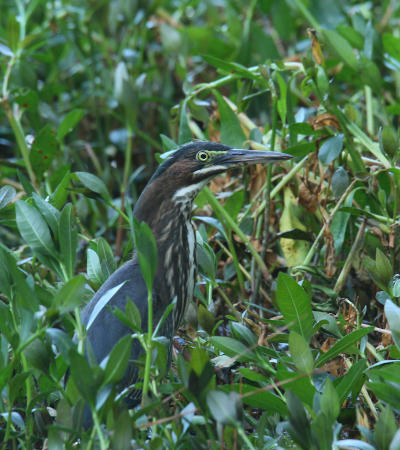 Much later on a different day, a green heron was being subtle and nearly escaped attention in the shade while working the water weeds on the edge of the pond. The larger image is tweaked from the color of the original, where I still had white balance set to ‘Sunlight’ and thus was a bit blue from the natural color of deep shade, as seen at left. I’d rather adjust color in post-production than let the camera figure it out, because I’m more accurate – I know what I’m looking at, and not just using an algorithm to ‘average out’ the various colors. But there was something about this particular heron that made me suspect it was one of the juveniles that I’d gotten video of two weeks previously, though I couldn’t really pin down what – behavior, mostly. On examining the frames afterward, there’s some faint evidence that I was correct; we’ll go in close on this same image (that makes three times) to get a peek at the head.
Much later on a different day, a green heron was being subtle and nearly escaped attention in the shade while working the water weeds on the edge of the pond. The larger image is tweaked from the color of the original, where I still had white balance set to ‘Sunlight’ and thus was a bit blue from the natural color of deep shade, as seen at left. I’d rather adjust color in post-production than let the camera figure it out, because I’m more accurate – I know what I’m looking at, and not just using an algorithm to ‘average out’ the various colors. But there was something about this particular heron that made me suspect it was one of the juveniles that I’d gotten video of two weeks previously, though I couldn’t really pin down what – behavior, mostly. On examining the frames afterward, there’s some faint evidence that I was correct; we’ll go in close on this same image (that makes three times) to get a peek at the head.

That looks like the last vestiges of baby down on the head, which seems about right, timewise. Yet this was the only glimpse that I’ve gotten of either since the initial video. Then again, it’s been hot and I haven’t been over there much.
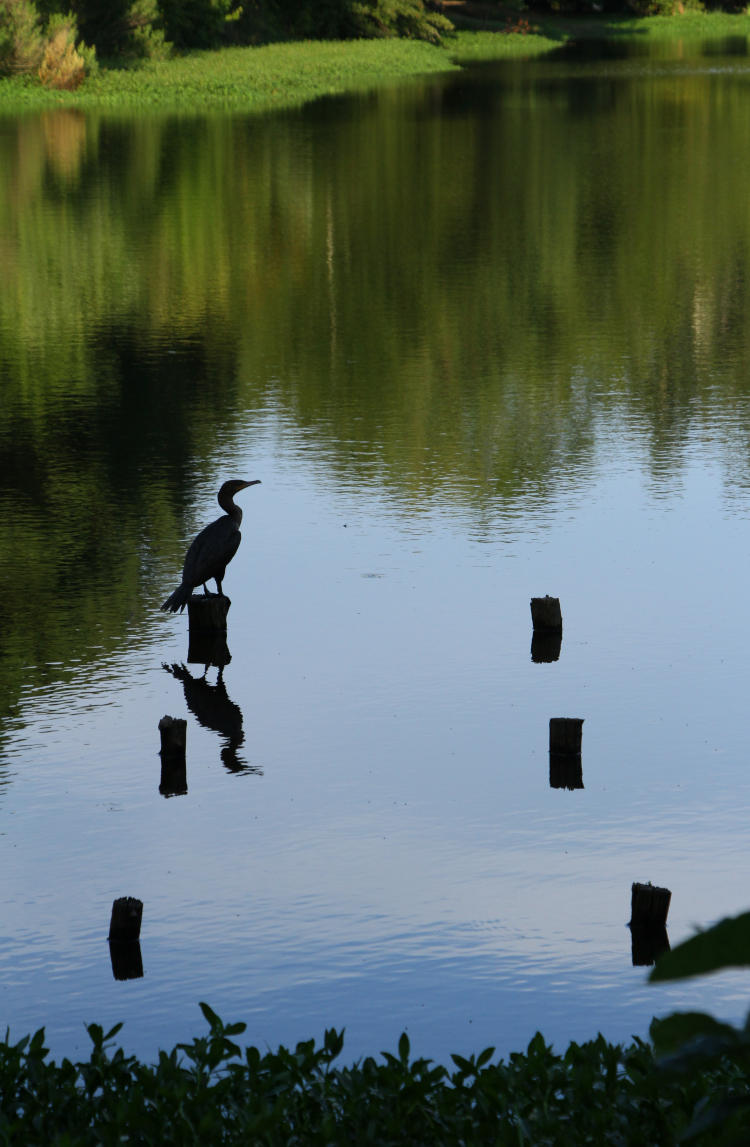
On the same day (in the same lighting conditions,) a double-crested cormorant (Nannopterum auritum) perched, as usual, on the old dock pilings, and I went a little wider for the scenic aspect. I’ll point out here that the reflections in the water provide specific shapes and colors, which can serve as useful backdrops or contrast for your subject; as you can imagine, the cormorant wouldn’t have stood out as well had it crossed over into the reflections of the trees, so yes, I shifted position until it fell into that gap. I could also have moved so that the cormorant itself was in the green, but the reflection in the water remained in the blue, providing a small discovery for those who glanced at the image too quickly (but no one does that, right?)
That’s enough birds – let’s do some bugs.
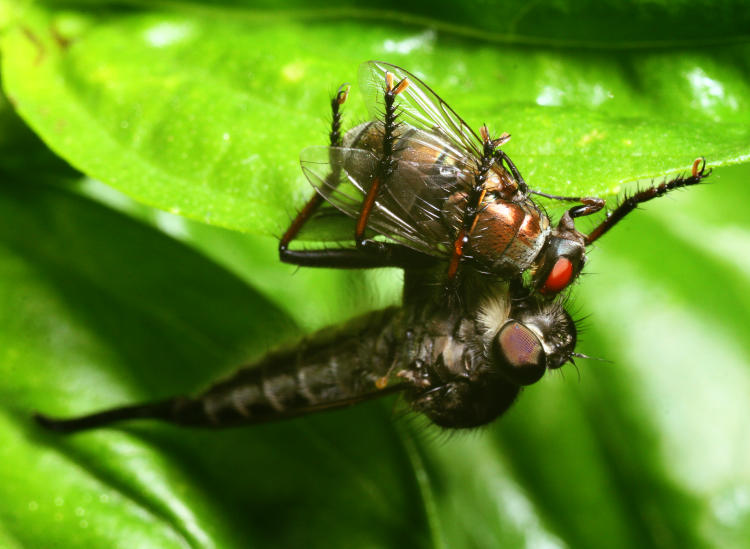
I spotted this giant robber fly (genus Promachus) while I was misting the basil plant, because they’re hard to miss, but didn’t realize it had prey until I leaned in a bit closer. Giant robber flies (that’s the real name, and there are numerous species) look absolutely nasty, and they are, but only to other flies – they’re pretty mellow around people, and will occasionally land on you if you’re holding still. They don’t bite or sting, so let them do their job clearing out the insects that you don’t want around. Unfortunately I caught the wings perfectly edge-on here and it made it look like it has none. I’ll do better next time…
Nearby, a Chinese mantis (Tenodera sinensis) was also preying around the basil plants, and received the benefit of the misting.

There are a handful able to be found in the yard now, if I look closely, and they’re about 3/4 adult size, pushing 70-80mm in length. They almost always appreciate a misting, especially in this weather, and you can see a water drop in the crook of its foreleg if you look closely. But seeing that ‘nose’ makes me realize that we haven’t had watermelon in a long time…
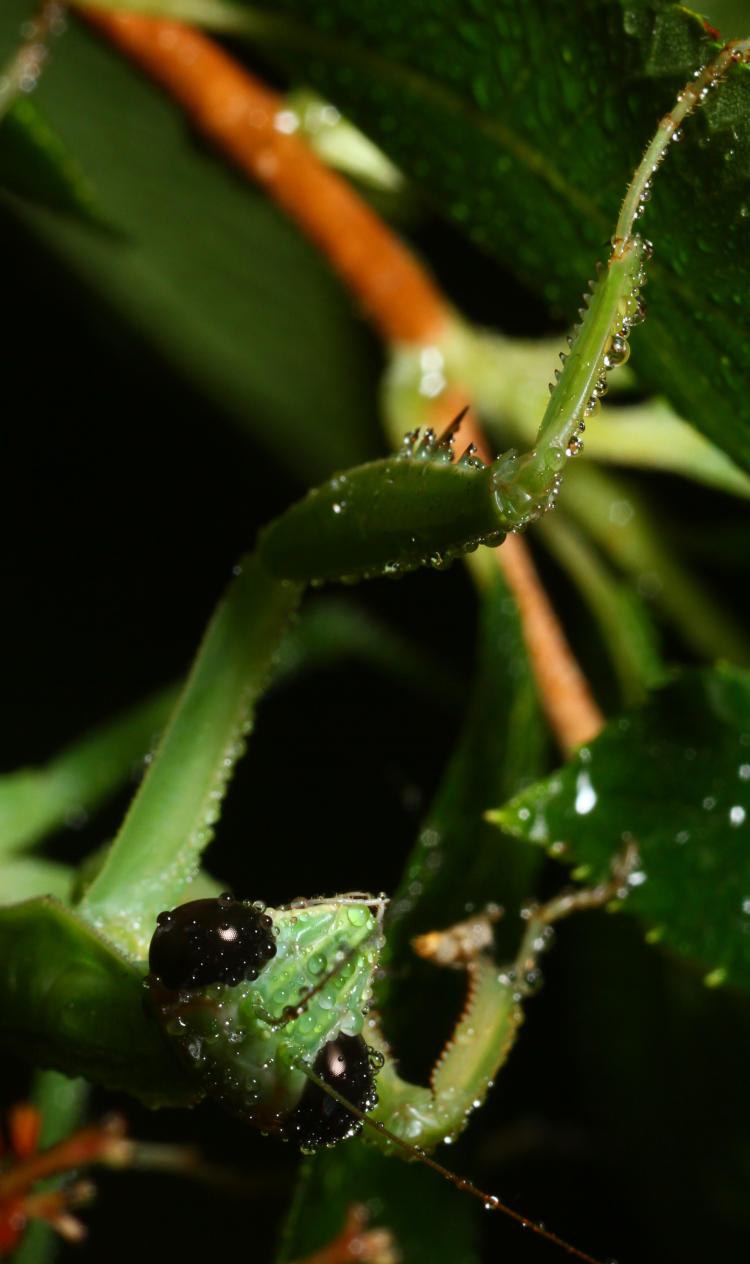
This one was over on the clethra bush, which was new this year and seems to be doing great, but I think I went a little overboard on the misting. There are no ill effects to be had from this, and believe me, some of the rains we’ve had recently were far worse, but the dramatic appearance works pretty well. You can tell from the dark eyes that this occurred at night, unlike the previous mantis. This image was shot eight days (well, nights) ago, and the mantis is still there as of this afternoon, probably gorging on the carpenter bees that adore the clethra flowers.
Since we’re getting back into the most prevalent species on the blog again, we’ll now have a green treefrog (Hyla cinerea.)

For a few days, this little guy was spending the daylight hours tucked into the ginger lilies that are getting established in the backyard, which seems typical – green treefrogs have a favorite hidey-hole for a few days, then move on to other locations. I would presume this helps them avoid predators somehow, perhaps from the ones that locate the frogs by their feces or something, because I would think that anything that finds a treefrog and eats treefrogs will simply eat the treefrog, and not have to come back later for dessert or something, but we’ve established by now that I’m not a herpetologist. That also means that I can’t answer why the nose is discolored in this manner – I’m guessing some kind of healing injury – but it sure changes the impression, doesn’t it? It went from simply being a frog to having a bit of a Durante-vibe (oh, look it up, whippersnapper.) I haven’t found this one since to see if there’s progress in healing.
And finally, the most recent images, from just last night.

Initially, I had a tighter crop of this one lined up for the month-end abstract before I realized that I had a better candidate already in the pipeline. After an abortive attempt to get some lightning pics and yet another horrendous downpour that still didn’t cool things off enough, the sky at sunset finally got pretty elaborate and I managed to time it right – I’ve said before, sunset after a clearing storm tends to be a great time for pics.
These are so colorful that we need another variation.
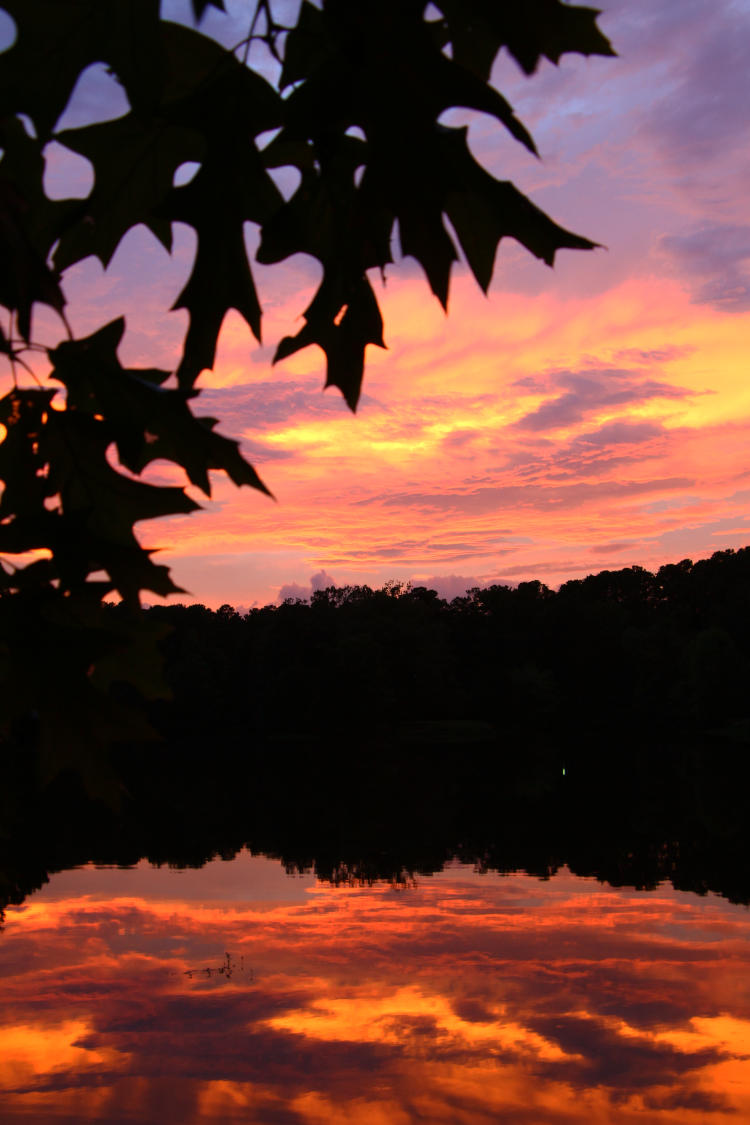
It has a nice tropical vibe, if you don’t look at the foreground leaves too closely – this is once again over at the neighborhood pond. I missed the opportunity to capture some of the residual thunderheads in this light, though you can see the barest evidence of another down on the horizon. I also missed having a bat silhouetted against that sky, but not through lack of trying – the light was too low, the bat too fast, to snag a sharp image, plus I had a maximum focal length of 135mm with the lens in hand, which isn’t really enough for something as small as a bat unless they’re really close. Maybe someday.
But yeah, that helps catch up the image count for the month, at least…




















































